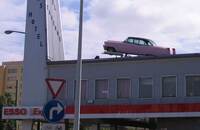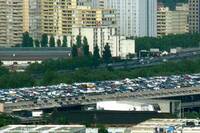- England
- Scotland
- France
- Holland
- Germany
- Italy
- Spain
- Portugal
- USA
- China
- Japan
- India
- Iran
- Advice
- Gardens
- England
- Scotland
- France
- Holland
- Germany
- Italy
- Spain
- Portugal
- USA
- China
- Japan
- India
- Iran
- Advice
- Garden Tours
Book: Landscape Planning and Environmental Impact Design: from EIA to EID
Chapter: Chapter 10 Sustainable green transport
If one seeks a single example of an assertion of simple-minded single purpose, the analytical rather than the synthetic view and indifference to natural process - indeed an anti-ecological view - then the highway creators leap to mind. There are other aspirants who vie to deface shrines and desecrate sacred cows, but surely it is the highway commissioner and engineer who most passionately embrace insensitivity and philistinism as way of life and profession. ...There they go, laden with money, offering the enormous bribe of ninety per cent of the cost of realising their narrow purposes. Give us your beautiful rivers and valleys and we will destroy them... Give us your cities, their historic areas and buildings, their precious parks, cohesive neighbourhoods, and we will rend them ï¾ in New Orleans, and Boston, San Francisco and Memphis. (McHarg 1971) Fortunately, dynasties do not last and sinners can repent. Writers, community groups, environmentalists, planners, landscape architects and others have been pouring their fire into the bastions of the highwaymen. Piles of bodies have accumulated in the moat. They are the bodies of those who died with their lungs and limbs damaged by the injurious side effects of road transport. Now, the bastions can be breached. We will have a more pluralistic approach to transport planning. Word derivation yields useful information on the history of transport routes (Tolley 1990: 162). Way, comes from the Latin via. Highway is a contraction of 'Kings highway'. It meant a public road, created and protected by sovereign power. 'Street' comes from the Latin strata (=paved) but now tends to mean a road bounded by contiguous buildings. 'Road' comes from the Old English ridan (=ride), which reminds us that a road's original purpose was to carry horse traffic [Fig 10.1]. 'Lanes' are routes contained within boundaries. 'Tracks' are not contained. 'Autoroutes' are for automobiles, which are self-powered. Rackham identifies three reasons for making a highway: to reach a destination, to provide a durable surface, to provide boundaries which prevent conflicts between travellers and residents. Regrettably, the rich history of different route types has been collapsed into a hierarchy of standard products: the inter-city autoroute, the local distributor and the residential access road. Cycleways and footways are made as 'baby roads' [Fig 10.2], forgetting the significant differences between car tyres, narrow-tyre bikes, wide-tyre bikes, feet city-shod, feet country-shod and feet in high-heeled shoes. Railways, canals, pedestrianisation schemes and park roads also suffer from single-purposism.

